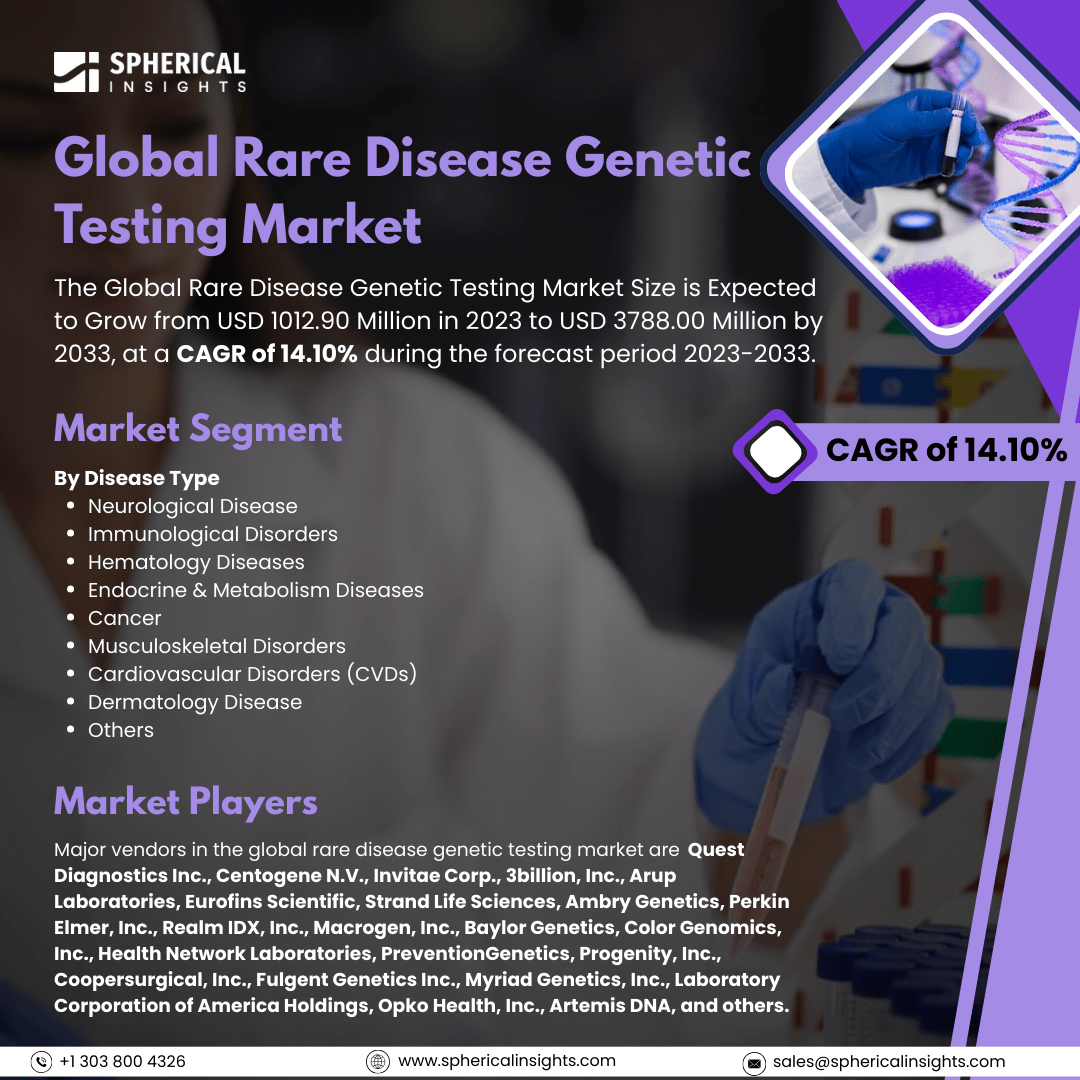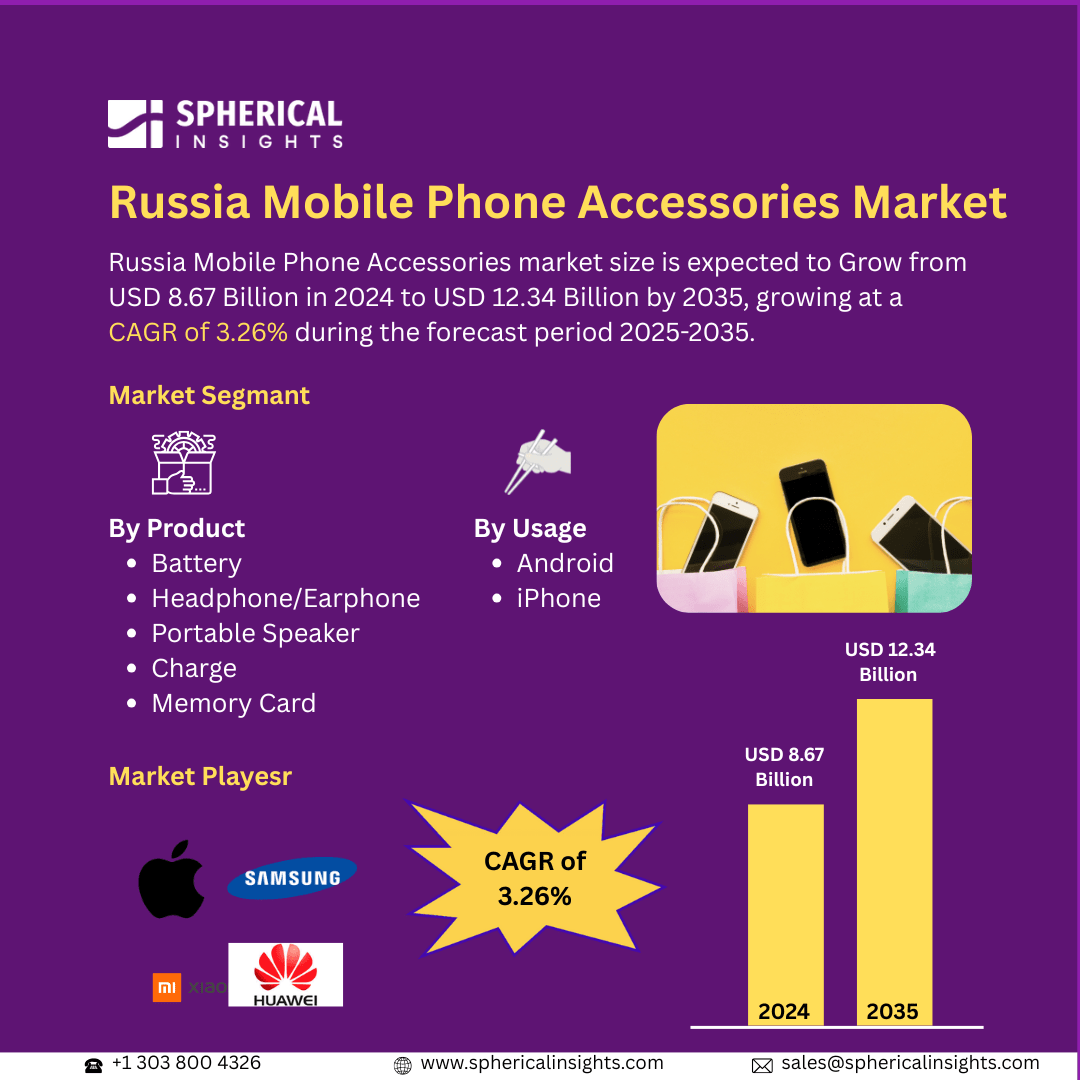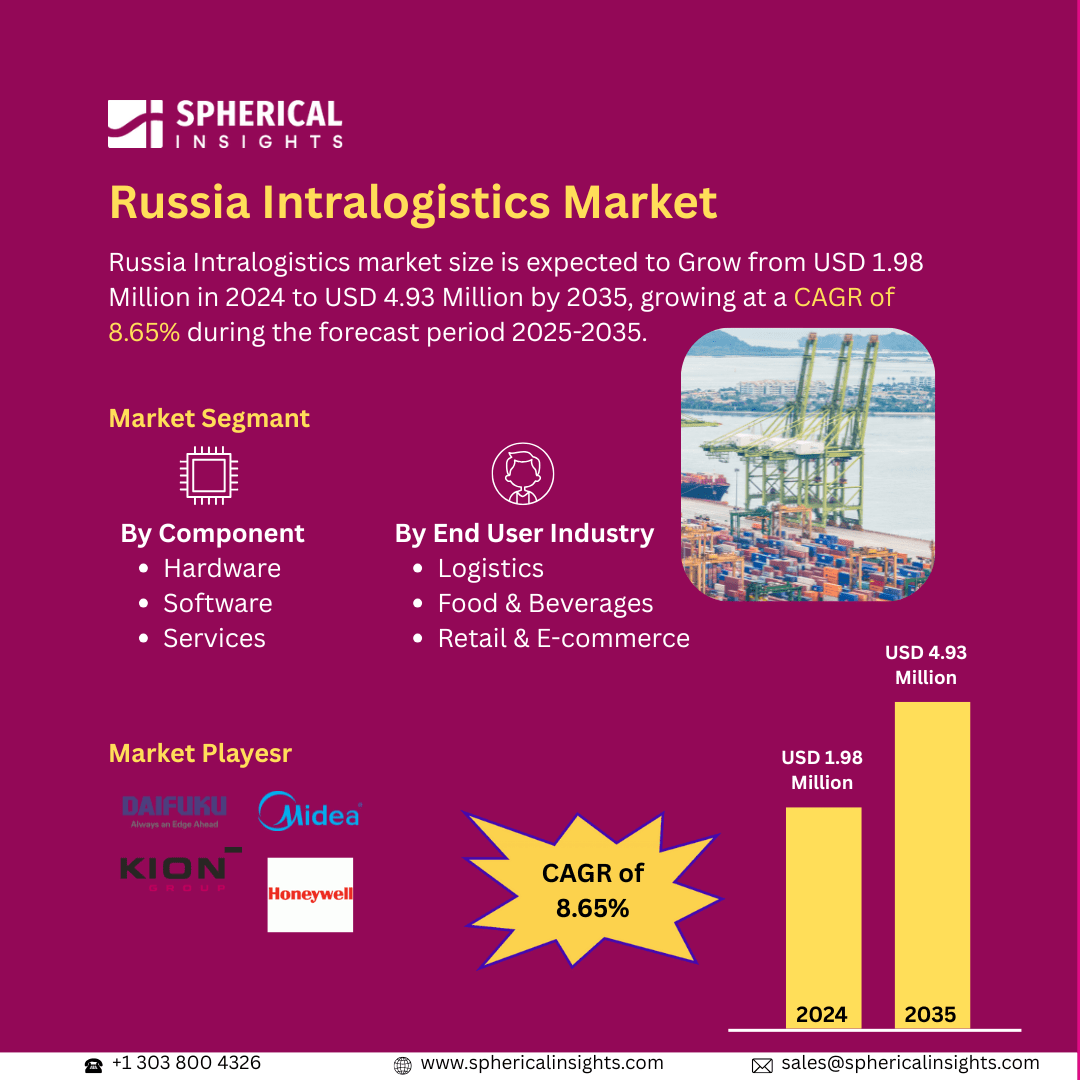Global Rare Disease Genetic Testing Market Size to Exceed USD 3788.00 Million by 2033
According to a research report published by Spherical Insights & Consulting, The Global Rare Disease Genetic Testing Market Size is Expected to Grow from USD 1012.90 Million in 2023 to USD 3788.00 Million by 2033, at a CAGR of 14.10% during the forecast period 2023-2033.
Browse 210 market data Tables and 45 Figures spread through 190 Pages and in-depth TOC on the Global Rare Disease Genetic Testing Market Size, Share, and COVID-19 Impact Analysis, By Disease Type (Neurological Disease, Immunological Disorders, Hematology Diseases, Endocrine & Metabolism Diseases, Cancer, Musculoskeletal Disorders, Cardiovascular Disorders (CVDs), Dermatology Disease, and Others), By Technology (Next-Generation Sequencing (NGS) [Whole Exome Sequencing and Whole Genome Sequencing], Array Technology, PCR-based Testing, FISH, Sanger Sequencing, and Karyotyping), By End-Use (Research Laboratories & CROs, Hospitals & Clinics, and Diagnostic Laboratories), and By Region (North America, Europe, Asia-Pacific, Latin America, Middle East, and Africa), Analysis and Forecast 2023 – 2033
The rare disease genetic testing market is the international market dedicated to the creation, manufacture, and sale of genetic tests that help diagnose rare diseases. The tests examine DNA, RNA, chromosomes, or proteins to detect genetic mutations and inherited conditions. It contains different testing technologies such as next-generation sequencing (NGS), whole genome sequencing, and gene panel testing, aiding in early detection, targeted therapy, and optimal disease management. The growth within this market is fueled by emerging genetic research developments, growing awareness, and accelerated demand for prompt and precise detection of rare conditions. Furthermore, the worldwide rare disease genetic testing market is propelled by the growing incidence of rare diseases, developments in next-generation sequencing (NGS) and genetic testing technology, and improving awareness among healthcare providers and patients. Encouraging government policies, increased demand for early and precise diagnosis, increasing research grants, and better healthcare infrastructure further drive the market. Decreasing costs of genetic testing also increases accessibility. However, the high testing costs, limited awareness, lack of specialized laboratories, delayed diagnosis, regulatory challenges, and insufficient insurance coverage for genetic testing procedures are key restraints for the growth of the market.
The endocrine & metabolism diseases segment accounted for the largest share in 2023 and is anticipated to grow at a significant CAGR during the forecast period.
On the basis of the disease type, the global rare disease genetic testing market is divided into neurological disease, immunological disorders, hematology diseases, endocrine & metabolism diseases, cancer, musculoskeletal disorders, cardiovascular disorders (CVDs), dermatology disease, and others. Among these, the endocrine & metabolism diseases segment accounted for the largest share in 2023 and is anticipated to grow at a significant CAGR during the forecast period. The segmental growth is attributed to the high prevalence of genetic metabolic disorders, increasing awareness, and advancements in genetic testing technologies. Improved diagnostic capabilities, growing research initiatives, and rising demand for early detection and personalized treatments further drive its significant CAGR growth during the forecast period.
The next-generation sequencing (NGS) segment accounted for the largest share in 2023 and is anticipated to grow at a remarkable CAGR throughout the forecast period.
On the basis of the technology, the global rare disease genetic testing market is divided into next-generation sequencing (NGS), array technology, PCR-based testing, FISH, sanger sequencing, and Karyotyping. The next-generation sequencing (NGS) is divided into whole Exome Sequencing and Whole Genome Sequencing. Among these, the next-generation sequencing (NGS) segment accounted for the largest share in 2023 and is anticipated to grow at a remarkable CAGR throughout the forecast period. The segmental growth is attributed to its high accuracy, cost-effectiveness, and ability to analyze multiple genes simultaneously. Increasing adoption in rare disease diagnosis, advancements in sequencing technologies, declining costs, and growing demand for personalized medicine are driving its remarkable CAGR growth throughout the forecast period.
The research laboratories & CROs segment accounted for the greatest share in 2023 and is anticipated to grow at a substantial CAGR over the forecast period.
On the basis of the end-use, the global rare disease genetic testing market is divided into research laboratories & CROs, hospitals & clinics, and diagnostic laboratories. Among these, the research laboratories & CROs segment accounted for the greatest share in 2023 and is anticipated to grow at a substantial CAGR over the forecast period. The segmental growth is attributed to the increasing genetic research initiatives, rising demand for outsourced testing services, and advancements in genomic technologies. Growing collaborations between pharmaceutical companies and CROs, expanding rare disease studies, and improved funding for genetic research are driving its substantial CAGR growth over the forecast period.
North America is projected to hold the largest share of the global Rare Disease Genetic Testing market over the forecast period.
North America is projected to hold the largest share of the global rare disease genetic testing market over the forecast period. The regional growth is attributed to its advanced healthcare infrastructure, strong presence of key market players, and increasing adoption of next-generation sequencing (NGS). Favorable government initiatives, high awareness, robust research funding, and widespread availability of genetic testing services further drive market growth in the region.
Asia Pacific is expected to grow at the fastest CAGR growth of the global rare disease genetic testing market during the forecast period. The regional growth is attributed to increasing awareness of genetic disorders, improving healthcare infrastructure, and rising government initiatives for rare disease diagnosis. Expanding access to advanced genetic testing, growing investments in research and development, and the presence of emerging biotechnology firms further drive market growth in the region.
Company Profiling
Major vendors in the global rare disease genetic testing market are Quest Diagnostics Inc., Centogene N.V., Invitae Corp., 3billion, Inc., Arup Laboratories, Eurofins Scientific, Strand Life Sciences, Ambry Genetics, Perkin Elmer, Inc., Realm IDX, Inc., Macrogen, Inc., Baylor Genetics, Color Genomics, Inc., Health Network Laboratories, PreventionGenetics, Progenity, Inc., Coopersurgical, Inc., Fulgent Genetics Inc., Myriad Genetics, Inc., Laboratory Corporation of America Holdings, Opko Health, Inc., Artemis DNA, and others.
Key Target Audience
- Market Players
- Investors
- End-users
- Government Authorities
- Consulting and Research Firm
- Venture capitalists
- Value-Added Resellers (VARs)
Market Segment
This study forecasts revenue at global, regional, and country levels from 2023 to 2033. Spherical Insights has segmented the global rare disease genetic testing market based on the below-mentioned segments:
Global Rare Disease Genetic Testing Market, By Disease Type
- Neurological Disease
- Immunological Disorders
- Hematology Diseases
- Endocrine & Metabolism Diseases
- Cancer
- Musculoskeletal Disorders
- Cardiovascular Disorders (CVDs)
- Dermatology Disease
- Others
Global Rare Disease Genetic Testing Market, By Technology
- Next-Generation Sequencing (NGS)
- Whole Exome Sequencing
- Whole Genome Sequencing
- Array Technology
- PCR-based Testing
- FISH
- Sanger Sequencing
- Karyotyping
Global Rare Disease Genetic Testing Market, By End-Use
- Research Laboratories & CROs
- Hospitals & Clinics
- Diagnostic Laboratories
Global Rare Disease Genetic Testing Market, By Regional
- North America
- Europe
- Germany
- UK
- France
- Italy
- Spain
- Russia
- Rest of Europe
- Asia Pacific
- China
- Japan
- India
- South Korea
- Australia
- Rest of Asia Pacific
- South America
- Brazil
- Argentina
- Rest of South America
- Middle East & Africa
- UAE
- Saudi Arabia
- Qatar
- South Africa
- Rest of the Middle East & Africa



